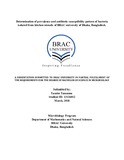| dc.description.abstract | Kitchen utensils become contaminated by people, food, pet or other environmental sources and cross contamination occurs. This study aimed at isolating, identifying, determining antibiotic susceptibility pattern and investigating antimicrobial activity of dishwashing liquid against the bacterial isolates collected from kitchen utensils (air, knife, spoon and cutting board) of BRAC University, Dhaka, Bangladesh. Eight samples collected through sterile swabs were kept for enrichment into nutrient broth at 37ºC for 24 hours and then cultured on various selective media. Identification of bacteria was done through conventional biochemical tests according to Bergey’s Manual of Systematic Bacteriology. Antibiotic susceptibility pattern of all isolates were performed against ten commercial antibiotic discs [Amoxicillin (10 μg), Ciprofloxacin (5 μg), Chloramphenicol (30 μg), Gentamycin (10 μg), Cefepime (30 μg), Penicillin-G (10 μg), Rifampicin (5 μg), Cefixime (5 μg), Trimethoprim-sulphamethoxazole (5 μg), Tetracycline (30 μg)] by using Kirby-Bauer disc diffusion method. Minimum Inhibitory Concentration (MIC) of commercially used dishwasher was also performed using Broth Microdilution method against six selected isolates. A total of about 43 bacterial isolates were identified where Staphylococcus sp. showed the highest prevalence 14 (32.56%), followed by Enterobacter sp. 7 (16.28%), Bacillus sp. 6 (13.95%), Vibrio sp. 5 (11.63%), Salmonella sp. 4 (9.30%), Klebsiella sp. 4 (9.30%), E.coli 2 (4.65%) and Shigella sp. 1 (2.33%). Antibiotic susceptibility pattern of the bacterial isolates showed that almost all of the isolates were resistant to at least two antibiotics and 74.42% were found resistant to more than two antibiotics. Broth Microdilution assay revealed that the highest MIC value (400 μl of stock solution) was showed by Salmonella spp. and Vibrio spp. showed the lowest MIC value (190 μl of stock solution). Besides, Bacillus spp., Staphylococcus spp., Shigella spp. and E. coli had shown the values 250 μl, 250 μl, 250 μl and 200 μl of stock solution respectively. These results indicate that kitchen utensils can be an important source of potential pathogens and food spoilage bacteria causing foodborne diseases. The spread of antibiotic resistant bacteria from kitchen utensils can be minimized by regular cleaning of kitchen utensils, use of dishwashing liquid and public awareness on personal hygiene. | en_US |

